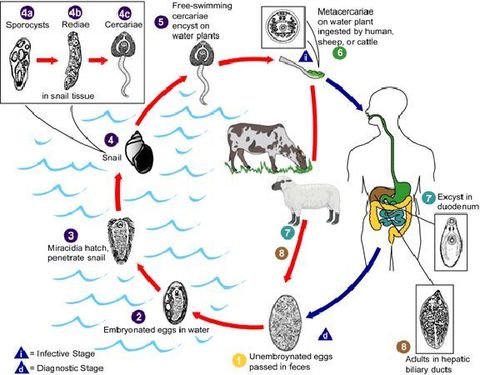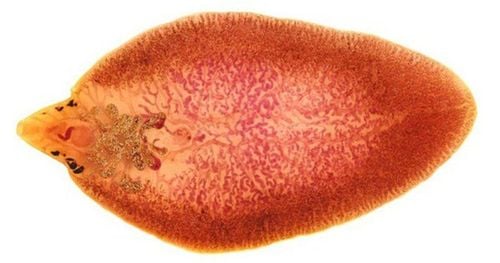This is an automatically translated article.
The article was consulted with Dr. Vo Thi Thuy Trang, Department of Medical Examination & Internal Medicine - Vinmec Danang International General Hospital.1. What is liver fluke?
The liver fluke is a parasite that looks like a leaf and has a flattened body. However, liver flukes have both male and female genitalia, so they are classified as hermaphrodites. The liver fluke will live in the liver and bile ducts of an infected person or animal.Liver flukes can be divided into 2 types, including small liver flukes and large liver flukes.
Large liver fluke: including 2 species with scientific names are Fasciola gigantica and Fasciola hepatica; Small liver fluke: includes 3 species with scientific names: Clonorchis sinensis, Opisthorchis viverrini and Opisthorchis felineus.
Trắc nghiệm: Làm thế nào để bảo vệ lá gan khỏe mạnh?
Làm test trắc nghiệm kiểm tra hiểu biết về gan có thể giúp bạn nhận thức rõ vai trò quan trọng của gan, từ đó có các biện pháp bảo vệ gan để phòng ngừa bệnh tật.2. Life cycle characteristics of liver fluke
Liver flukes are characterized by their rather complex life cycle. They parasitize in the liver and bile ducts of humans or some herbivores such as cows, buffaloes, goats, sheep,...Adult liver flukes begin to lay eggs, the eggs will follow the bile duct to the intestines. and out in feces. When the eggs meet the water, they hatch into hairy larvae (miracidium), which takes 9 to 21 days to complete this process into the liver fluke larvae.
Liver fluke larvae will choose snails of the genus Limnea as an intermediate host and develop into tail larvae (cercaria) over a period of 6 to 7 weeks. When the hairy larvae leave the shell, they swim freely in the water or attach to aquatic plants to form larval cysts (metacercaria).

The time from infection to the time when faeces carry the liver fluke eggs out will be different between humans and animals. In humans it takes about 3 to 4 months, in herbivores like cattle it takes only 6 to 13 weeks. This time also depends on the number of flukes, the maturation time will be longer if the flukes are more numerous. The lifespan of the human liver fluke ranges from 9 to 13.5 years.
3. Symptoms of liver fluke disease
During the incubation period of liver fluke, it will be difficult to detect obvious signs of disease because it depends on the number of larvae that the patient has eaten. Normally, for small liver flukes, people must be infected with more than 100 flukes to have obvious symptoms.Because the liver fluke is parasitic and lays eggs in the liver and bile ducts, it can cause the infected person to have some of the following symptoms:
Jaundice or blue, pale skin: When the liver fluke is parasitic in the body Humans will cause blockage and infection of the liver and bile ducts. Therefore, if the patient is infected with the liver fluke, it will be manifested by yellow or blue, pale skin. Besides, in some cases of liver fluke infection, the green, pale skin condition can also be caused by vomiting, loss of appetite, diarrhea; Irritability, nausea, vomiting and diarrhea: These are all caused by blocked bile ducts. Depending on the severity of the liver fluke infection, these symptoms can last from a few weeks to several months; Abdominal pain: Abdominal cramps occur when liver flukes move from the intestine to the liver, pass through Glisson to enter the liver or enter the bile duct and cause the bile duct to become blocked; Weight loss: The liver fluke infection makes the patient lose appetite, causing anorexia. Therefore, patients with liver flukes for a long time will easily lose weight; Rash: In the early stages when the liver fluke invades the liver, a skin rash is a fairly common symptom. This is the result that occurs when the body's immune system reacts to the infection caused by the liver fluke in the liver; Fever: Parasitic liver flukes cause blockage of the bile ducts, infection can occur and cause the patient to have a fever.

4. How to prevent liver fluke disease
Based on the characteristics of the liver fluke life cycle, you can prevent liver fluke disease by the following ways:Before eating vegetables grown under water, it is necessary to wash vegetables thoroughly and boil them thoroughly; Absolutely do not eat raw, unprocessed food such as raw liver, blood soup, salad, ... Cook cooked and drink boiled and use clean water to drink, need to boil thoroughly before drinking; Do not eat snails or fish if they have not been thoroughly cooked; Maintain the habit of washing hands with soap before eating and after using the toilet; Periodically perform deworming every 6 months; The study of the life cycle characteristics of the liver fluke has played a significant role in controlling the spread of the disease. When detecting that the body has abnormal symptoms of liver fluke disease, the patient should immediately go to medical facilities for examination, liver fluke tests and timely treatment, in order to limit the risk of liver fluke disease. prevent damage to the bile ducts and liver.
Vinmec International General Hospital is an effective address for examination, diagnosis, testing and treatment of liver fluke disease. At Vinmec Central Park International General Hospital, the liver fluke disease was cured after only 3 days of treatment. In particular, in order to improve the results of accurate diagnosis of the disease, at present, Vinmec is fully equipped with imaging diagnostic facilities such as CT, MRI, liver ultrasound, ELISA test, bile fluid test, etc. .. the most modern to find parasites, liver flukes, parasites in humans. Therefore, when there are signs of illness, you can go to Vinmec International General Hospital for examination and treatment.
Please dial HOTLINE for more information or register for an appointment HERE. Download MyVinmec app to make appointments faster and to manage your bookings easily.














